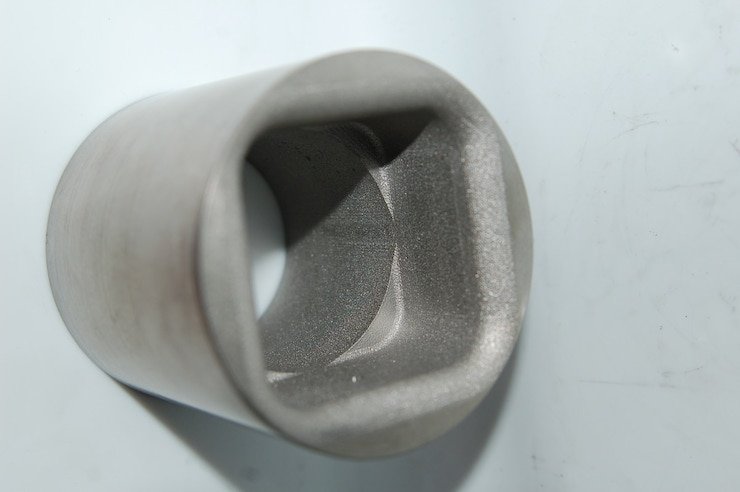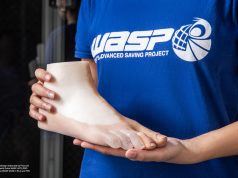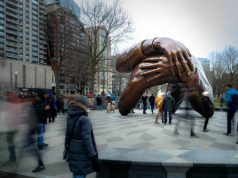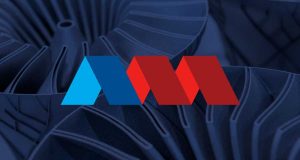It started with a piece here, a small part there, but since its inception in the facility, additive manufacturing, more commonly known as 3D printing, has evolved and blossomed at Arnold Engineering Development Complex Hypervelocity Wind Tunnel 9 in White Oak, Maryland. From plastic rigs to elements vital to tunnel operations, a multitude of components can now be fabricated in-house.
“The success of AM at Tunnel 9 is exciting to say the least,” said Tunnel 9 system and nitrogen supply engineer Samuel Gigioli. “The plastic prototyping is a growing interest here, as more and more people are coming to me with an interest or a need for 3D printing parts. We can spit out parts in a matter of hours rather than weeks. Whether it is a test fit piece or a prototype part, the process greater speeds up our operations and can greatly impact Tunnel 9’s mission success.”
And this may be just the beginning.
Around seven years ago, Tunnel 9 acquired its first 3D printer – a small filament-based device that could be used to quickly churn out some uncomplicated plastic parts. However, this “hobby” printer would soon find its way to storage as the prints coming from it were unsuccessful.
In 2019, during his first summer working at Tunnel 9, Gigioli was tasked with reviving the printer capabilities. This included ordering new parts, filament and materials for the apparatus. The second round with the printer proved to be more successful than the first. Following its reintroduction, AM at Tunnel 9 was used primarily to manufacture plastic mounting rigs, fixtures, gauges and things of that sort.
Spurred by this progress, Tunnel 9 subsequently acquired two additional 3D printers. One, a resin-based printer, is able to print small yet highly-detailed and strong parts. The other, a dual filament-based printer, is capable of consistently printing large and highly-detailed parts.
“There have been a few prototypes applied to the tunnel,” Gigioli said. “In fact, a very critical aero-optic part was prototyped with our resin printer, but most prints are rigs, test fit gauges or other miscellaneous parts.”
It wouldn’t be long before Gigioli, now regarded as the Tunnel 9 3D printing “guru,” took on a greater role in the AM efforts and projects themselves took on a greater level of importance.
In February 2020, a research and development project involving the additive manufacture of refractive metal hardware launched at Tunnel 9. Gigioli soon took charge of this effort, one that aimed to reduce lead time and manufacturing costs for some high-temperature parts used in Tunnel 9.
“These Tunnel 9 parts endure very cyclic, high-pressure and -temperature conditions, so the lifespan on these parts is significantly shorter than other parts in the tunnel,” Gigioli said. “These parts can experience up to 3,000 degrees Fahrenheit. This is why refractive metals are chosen, as they are metals that can withstand extreme heat with relatively little deformation.”
The ongoing AM research and development effort is led by Gigioli, who is responsible for the upkeep of AM materials, devices and printers, and Tunnel 9 Chief Facility Engineer Nicholas Fredrick. They work with a pair of contractor teams, one of which prints the parts and handles the entire manufacturing process from start to finish, and another which supplies the printing powder and analyzes material characteristics.
Perhaps the most significant accomplishment of the research and development program thus far has been the successful manufacture of a component known as the petal orifice liner. This device, integral to high Mach number tunnel runs, is situated between the two burst diaphragms that Tunnel 9 uses to act as a high-speed valve.
AM typically uses a computer, 3D modeling software, machine equipment and layering material. Once an item is designed using the software, the AM equipment then reads the data to fabricate a three-dimensional version of the object. Materials used in the process can include a variety filaments, polymers and metals. Through AM, layers of materials are joined or fused together to create the specified object.
In the case of a refractive metal part, AM is completed through a process known as laser-powder bed fusion. With this method, the metal begins as a highly-refined and -controlled metal powder. A high-powered laser is applied to this powder, and it essentially melts the metal particles layer-by-layer until the piece is formed according to specifications.
The AM liner, Gigioli said, has outperformed its wrought-built counterpart that has been used for decades in the facility.
“The part is cheaper to manufacture, quicker to manufacture and deliver, and is more resilient to the cyclic temperature loading,” Gigioli said. “The AM process creates very unique microstructures within the material and, as a result, the part’s structural and thermal properties are different than traditional wrought billets metal.”
Those involved in AM at Tunnel 9 have already begun work on the next 3D-printed part to be applied in high Mach number conditions. This component, a particle separator, would act to weed out any airborne particles in the gas flow without hindering any mass flow in the tunnel.
“We are still awaiting the component to be fully finished, but we hope to implement the component in a test program starting around September,” he said.
The success of the 3D printing program at Tunnel 9 has sparked conversations among team members about potential future AM projects.
“Myself and the people involved in this R&D project are excited for what the future holds for AM,” Gigioli said.
Their efforts to this point haven’t gone unnoticed. Part of the team’s research effort involves showcasing the potential of AM for the entire Department of Defense. Gigioli said personnel from various DOD components have already chimed in to compliment the Tunnel 9 team’s success and express their astonishment with the AM technology or extol its potential.
With the success of the AM petal orifice liner still on his mind, Gigioli said the possibilities for 3D printing could be boundless.
“Imagine if we scale this process up to multiple tunnel parts or even entire systems,” he said. “Now some DOD components are interested in printing test models or leading edge models.
“I hope to continue leading Tunnel 9 down this path and increase our success through this technology.”
For more information about Arnold Air Force Base, please visit www.arnold.af.mil.
Subscribe to our Newsletter
3DPResso is a weekly newsletter that links to the most exciting global stories from the 3D printing and additive manufacturing industry.























